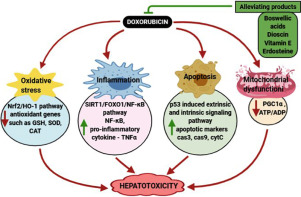Our official English website, www.x-mol.net, welcomes your
feedback! (Note: you will need to create a separate account there.)
New molecular and biochemical insights of doxorubicin-induced hepatotoxicity.
Life Sciences ( IF 5.2 ) Pub Date : 2020-03-29 , DOI: 10.1016/j.lfs.2020.117599 Pureti Lakshmi Prasanna 1 , Kaviyarasi Renu 1 , Abilash Valsala Gopalakrishnan 1
Life Sciences ( IF 5.2 ) Pub Date : 2020-03-29 , DOI: 10.1016/j.lfs.2020.117599 Pureti Lakshmi Prasanna 1 , Kaviyarasi Renu 1 , Abilash Valsala Gopalakrishnan 1
Affiliation

|
Chemotherapeutic antibiotic doxorubicin belongs to the anthracycline class, slaughters not only the cancer cells but also non-cancerous cells even in the non-targeted organs thereby resulting in the toxicity. The liver is primarily involved in the process of detoxification and this mini-review we focused mainly to investigate the molecular mechanisms heading hepatotoxicity caused due to doxorubicin administration. The alterations in the doxorubicin treated liver tissue include vacuolation of hepatocytes, degeneration of hepatocyte cords, bile duct hyperplasia and focal necrosis. About the literature conducted, hepatotoxicity caused by doxorubicin has been explained by estimating the levels of liver serum biomarkers, ROS production, antioxidant enzymes, lipid peroxidation, and mitochondrial dysfunction. The liver serum biomarkers such as ALT and AST, elated levels of free radicals inducing oxidative stress characterized by a surge in Nrf-2, FOXO-1 and HO-1 genes and diminution of anti-oxidant activity characterized by a decline in SOD, GPx, and CAT genes. The augmented levels of SGOT, SGPT, LDH, creatine kinase, direct and total bilirubin levels also reveal the toxicity in the hepatic tissue due to doxorubicin treatment. The molecular insight of hepatotoxicity is mainly due to the production of ROS, ameliorated oxidative stress and inflammation, deteriorated mitochondrial production and functioning, and enhanced apoptosis. Certain substances such as extracts from medicinal plants, natural products, and chemical substances have been shown to produce an alleviating effect against the doxorubicin-induced hepatotoxicity are also discussed.
中文翻译:

阿霉素诱导的肝毒性的新分子和生化见解。
化学治疗的抗生素阿霉素属于蒽环类,不仅杀死癌细胞,而且甚至杀死非靶器官的非癌细胞,也因此导致毒性。肝脏主要参与排毒过程,本次迷你回顾主要集中于研究由于阿霉素引起的肝毒性分子机制。经阿霉素处理的肝组织的改变包括肝细胞空泡化,肝细胞索变性,胆管增生和局灶性坏死。关于所进行的文献,阿霉素引起的肝毒性已经通过估计肝脏血清生物标志物的水平,ROS产生,抗氧化酶,脂质过氧化和线粒体功能障碍来解释。肝脏血清生物标志物(例如ALT和AST),自由基的高水平诱导氧化应激,其特征是Nrf-2,FOXO-1和HO-1基因的激增,抗氧化活性的降低,其特征是SOD,GPx的下降和CAT基因。SGOT,SGPT,LDH,肌酸激酶,直接和总胆红素水平的增加也显示了由于阿霉素治疗对肝组织的毒性。肝毒性的分子见解主要归因于ROS的产生,氧化应激和炎症的减轻,线粒体产生和功能的恶化以及细胞凋亡的增强。还讨论了某些物质,例如药用植物的提取物,天然产物和化学物质,可产生对抗阿霉素诱导的肝毒性的缓解作用。引起氧化应激的自由基水平升高,其特征是Nrf-2,FOXO-1和HO-1基因激增,抗氧化活性降低,其特征是SOD,GPx和CAT基因下降。SGOT,SGPT,LDH,肌酸激酶,直接和总胆红素水平的增加也显示了由于阿霉素治疗对肝组织的毒性。肝毒性的分子见解主要归因于ROS的产生,氧化应激和炎症的减轻,线粒体产生和功能的恶化以及细胞凋亡的增强。还讨论了某些物质,例如药用植物的提取物,天然产物和化学物质,可产生对抗阿霉素诱导的肝毒性的缓解作用。引起氧化应激的自由基水平升高,其特征是Nrf-2,FOXO-1和HO-1基因激增,抗氧化活性降低,其特征是SOD,GPx和CAT基因下降。SGOT,SGPT,LDH,肌酸激酶,直接和总胆红素水平的增加也显示了由于阿霉素治疗对肝组织的毒性。肝毒性的分子见解主要归因于ROS的产生,氧化应激和炎症的减轻,线粒体产生和功能的恶化以及细胞凋亡的增强。还讨论了某些物质,例如药用植物的提取物,天然产物和化学物质,可产生对抗阿霉素诱导的肝毒性的缓解作用。
更新日期:2020-03-30
中文翻译:

阿霉素诱导的肝毒性的新分子和生化见解。
化学治疗的抗生素阿霉素属于蒽环类,不仅杀死癌细胞,而且甚至杀死非靶器官的非癌细胞,也因此导致毒性。肝脏主要参与排毒过程,本次迷你回顾主要集中于研究由于阿霉素引起的肝毒性分子机制。经阿霉素处理的肝组织的改变包括肝细胞空泡化,肝细胞索变性,胆管增生和局灶性坏死。关于所进行的文献,阿霉素引起的肝毒性已经通过估计肝脏血清生物标志物的水平,ROS产生,抗氧化酶,脂质过氧化和线粒体功能障碍来解释。肝脏血清生物标志物(例如ALT和AST),自由基的高水平诱导氧化应激,其特征是Nrf-2,FOXO-1和HO-1基因的激增,抗氧化活性的降低,其特征是SOD,GPx的下降和CAT基因。SGOT,SGPT,LDH,肌酸激酶,直接和总胆红素水平的增加也显示了由于阿霉素治疗对肝组织的毒性。肝毒性的分子见解主要归因于ROS的产生,氧化应激和炎症的减轻,线粒体产生和功能的恶化以及细胞凋亡的增强。还讨论了某些物质,例如药用植物的提取物,天然产物和化学物质,可产生对抗阿霉素诱导的肝毒性的缓解作用。引起氧化应激的自由基水平升高,其特征是Nrf-2,FOXO-1和HO-1基因激增,抗氧化活性降低,其特征是SOD,GPx和CAT基因下降。SGOT,SGPT,LDH,肌酸激酶,直接和总胆红素水平的增加也显示了由于阿霉素治疗对肝组织的毒性。肝毒性的分子见解主要归因于ROS的产生,氧化应激和炎症的减轻,线粒体产生和功能的恶化以及细胞凋亡的增强。还讨论了某些物质,例如药用植物的提取物,天然产物和化学物质,可产生对抗阿霉素诱导的肝毒性的缓解作用。引起氧化应激的自由基水平升高,其特征是Nrf-2,FOXO-1和HO-1基因激增,抗氧化活性降低,其特征是SOD,GPx和CAT基因下降。SGOT,SGPT,LDH,肌酸激酶,直接和总胆红素水平的增加也显示了由于阿霉素治疗对肝组织的毒性。肝毒性的分子见解主要归因于ROS的产生,氧化应激和炎症的减轻,线粒体产生和功能的恶化以及细胞凋亡的增强。还讨论了某些物质,例如药用植物的提取物,天然产物和化学物质,可产生对抗阿霉素诱导的肝毒性的缓解作用。







































 京公网安备 11010802027423号
京公网安备 11010802027423号